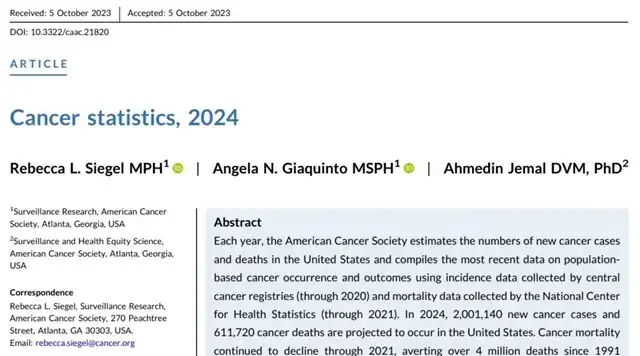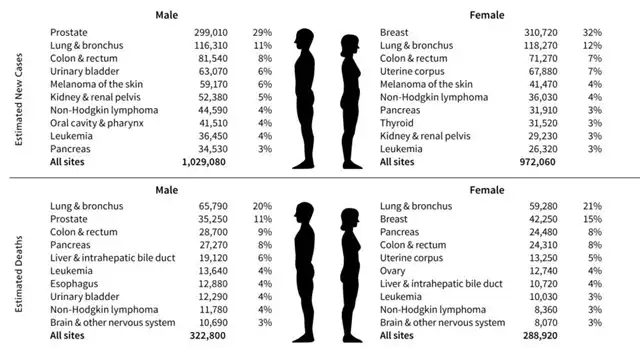2024 Cancer Statistics: Over 2 Million New Cases Projected in US
- Normal Liver Cells Found to Promote Cancer Metastasis to the Liver
- Nearly 80% Complete Remission: Breakthrough in ADC Anti-Tumor Treatment
- Vaccination Against Common Diseases May Prevent Dementia!
- New Alzheimer’s Disease (AD) Diagnosis and Staging Criteria
- Breakthrough in Alzheimer’s Disease: New Nasal Spray Halts Cognitive Decline by Targeting Toxic Protein
- Can the Tap Water at the Paris Olympics be Drunk Directly?
2024 Cancer Statistics: Over 2 Million New Cases Projected in US
- Should China be held legally responsible for the US’s $18 trillion COVID losses?
- CT Radiation Exposure Linked to Blood Cancer in Children and Adolescents
- FDA has mandated a top-level black box warning for all marketed CAR-T therapies
- Can people with high blood pressure eat peanuts?
- What is the difference between dopamine and dobutamine?
- How long can the patient live after heart stent surgery?
2024 Cancer Statistics: Over 2 Million New Cases Projected in US
In 2024, the United States is expected to see a record-breaking number of new cancer cases, surpassing 2 million for the first time, with the incidence of six out of the top ten killers on the rise!
The annual Cancer Annual magazine has been updated again. Let’s take a look at the noteworthy data from this year’s cancer statistics!
According to statistical data analysis estimates, in 2024, the United States is projected to have 2,001,140 new cancer cases and 611,720 cancer-related deaths.
This marks the first time the annual incidence of cancer in the United States has exceeded 2 million, equivalent to nearly 5,500 new cases per day or one person being diagnosed with cancer every 15 seconds.
While increased diagnoses may not be entirely negative, as early detection leads to better treatment outcomes, it’s crucial to note that among the top ten deadly cancers, the incidence of six is quietly rising, especially among individuals under the age of 50, where colorectal cancer has become a significant concern.
Specific data is explained below.

In 2024, the projected number of new cancer cases in the United States is 2,001,140, with approximately 5,480 new cases per day, as seen in the categorized data by cancer type and gender in the following chart.
The lifetime incidence of invasive cancer is slightly higher in males (41.6%) than in females (39.6%). Traditionally, due to different environmental exposures and risky behaviors, males have been more prone to cancer. However, it’s worth noting that in recent years, the incidence of cancer in females has also increased, narrowing the gap between male and female cancer rates. This may indicate a shift in the sources of cancer risk towards common factors affecting different genders, such as obesity and prolonged sitting.
Age remains the most significant risk factor for cancer, but the proportion of new cases in adults aged 65 and above has decreased from 61% in 1995 to 58% in 2019-2020. This decline is noteworthy given the aging population, with the percentage of individuals aged 65 and above growing from 13% to 17% during the same period.
In contrast, the proportion of new cancer cases in adults aged 50-64 has increased from 25% to 30%, while their population percentage has grown from 13% to 19%.
Researchers believe this trend may reflect the decreasing incidence of prostate cancer and smoking-related cancers in older males, coupled with an increased risk of cancer due to higher obesity rates among those born after 1950.

The chart above illustrates the most common cancers in both sexes.
In males, prostate cancer, lung and bronchus cancer, and colorectal cancer together account for 48%, with prostate cancer alone contributing 29%. In females, breast cancer, lung cancer, and colorectal cancer together account for 51%, with breast cancer alone representing 32%.
The estimated number of cancer-related deaths in the United States in 2024 is 611,720, equivalent to 1,680 deaths per day. Lung cancer, colorectal cancer, and pancreatic cancer have the highest mortality rates.
It is estimated that approximately 340 people die from lung cancer every day, nearly 2.5 times the deaths from colorectal cancer. Researchers estimate that among the 125,070 lung cancer deaths, 81% are attributable to smoking, and 3,500 can be attributed to secondhand smoke.
When isolated from smoking-related cases, the death toll from non-smoking-related lung cancer is approximately 20,300, ranking eighth among all cancer types.
The chart below shows the variation in cancer incidence rates from 1975 to 2020, with a 9% decrease in the overall incidence rate in 2020 compared to 2019. This is partly influenced by the delayed diagnosis of non-lethal/asymptomatic cancers during the COVID-19 pandemic in 2020.
Fluctuations in male cancer incidence rates are mainly influenced by prostate-specific antigen (PSA) testing. The increase in breast cancer, endometrial cancer, and melanoma incidence rates among females offsets the decrease in lung and colorectal cancer incidence rates, resulting in an overall upward trend.
The gender ratio of cancer incidence rates has decreased from 1.59 in 1992 to 1.14 in 2020, indicating a gradual reduction in the gap between male and female cancer rates. Notably, due to the high incidence of breast and thyroid cancers, the cancer incidence rate in females under 50 is 70% higher than that in males.
Around 2005, the incidence rate of breast cancer in females increased slowly at approximately 0.6% annually, with a greater increase in those under 50 than those over 50. This rise can be partly attributed to a decline in fertility rates and an increase in obesity rates. During the same period, the incidence rate of endometrial cancer in females increased by about 1% annually.
Due to changes in thyroid cancer screening recommendations, the incidence rate of thyroid cancer has decreased by approximately 2% annually since 2014, but the incidence rate in adolescents aged 15-19 has not decreased.
Colorectal cancer is another cause for concern. The decline in the incidence rate of colorectal cancer is primarily due to a decrease in the elderly population aged 65 and above. In those under 55, the incidence rate of colorectal cancer is increasing at a rate of 1%-2% annually. Colorectal cancer is now the leading cause of death in young males and the second in females, representing a significant increase compared to the late 1990s when it was the fourth leading cause of cancer death in individuals under 50.
Lastly, let’s examine the changes in cancer death rates.
The trend in death rates is primarily influenced by lung cancer. Due to a reduction in smoking, improved screening, and advances in treatment methods, the death rate from lung cancer has significantly decreased. However, even so, the number of deaths caused by lung cancer still far exceeds other cancer types. Currently, there is room for improvement in the U.S. lung cancer screening rate, and further reductions in lung cancer mortality are possible.
When stratified by age, the cancer death rate in individuals under 50 has decreased by nearly 2% annually since 1975. Among males, there is a significant decrease in the death rate from lung cancer and leukemia, but an increase in colorectal cancer death rate. In females, there is a decrease in lung cancer death rate, an increase in colorectal cancer death rate, and a simultaneous increase in cervical cancer death rate.
Overall, the cancer death rate in the United States has continued to decline, decreasing by 33% since 1991, thanks to reduced smoking, early diagnosis, and advances in treatment, such as targeted therapy and immunotherapy.
However, cancer prevention efforts appear to be less effective, as the incidence of six out of the top ten cancers is increasing. These include breast cancer, prostate cancer, endometrial cancer, pancreatic cancer, oral cancer, liver cancer (in females), kidney cancer, and melanoma, as well as colorectal cancer and cervical cancer in young individuals.
2024 Cancer Statistics: Over 2 Million New Cases Projected in US
References:
[1]https://acsjournals.onlinelibrary.wiley.com/doi/10.3322/caac.21820
[2]https://acsjournals.onlinelibrary.wiley.com/doi/10.3322/caac.21824
(source:internet, reference only)
Disclaimer of medicaltrend.org
Important Note: The information provided is for informational purposes only and should not be considered as medical advice.



